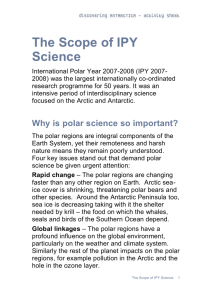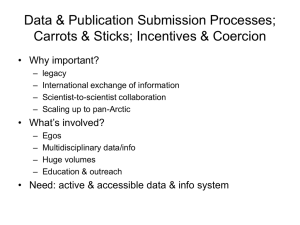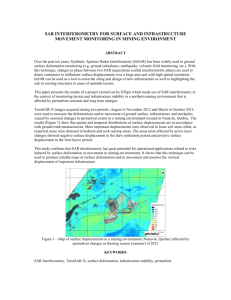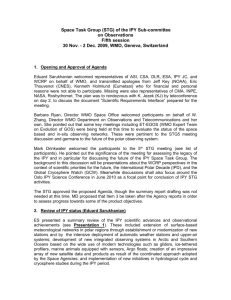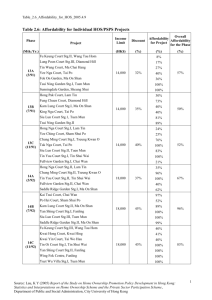A Data Processing Strategy for Satellite Data Collected during the IPY
advertisement
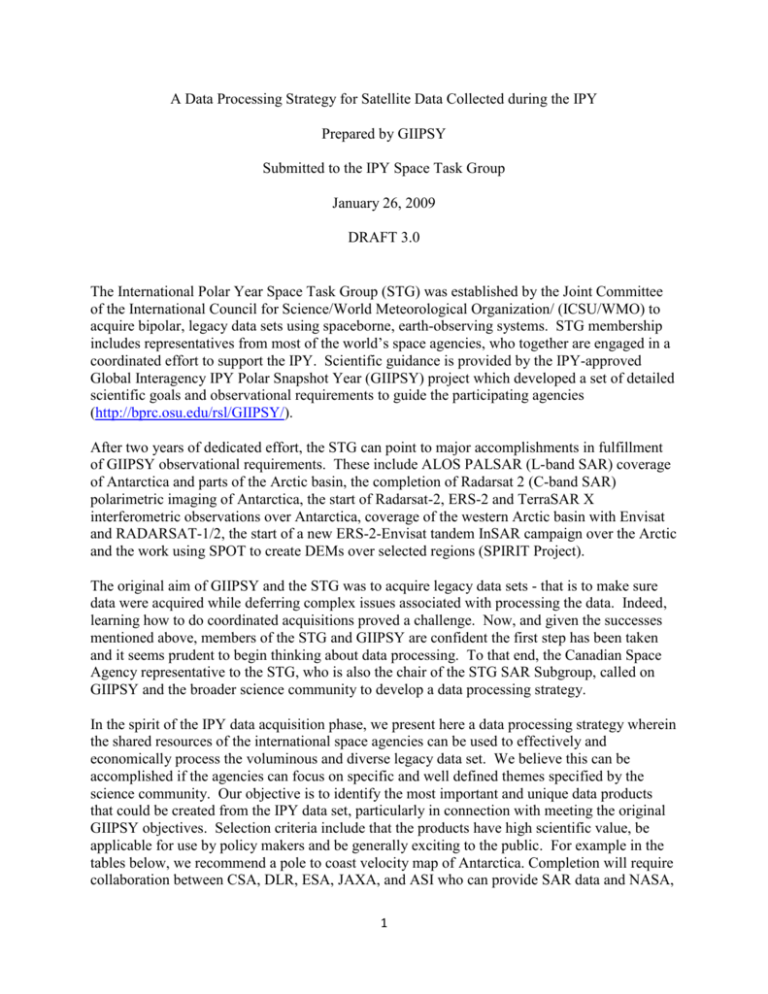
A Data Processing Strategy for Satellite Data Collected during the IPY Prepared by GIIPSY Submitted to the IPY Space Task Group January 26, 2009 DRAFT 3.0 The International Polar Year Space Task Group (STG) was established by the Joint Committee of the International Council for Science/World Meteorological Organization/ (ICSU/WMO) to acquire bipolar, legacy data sets using spaceborne, earth-observing systems. STG membership includes representatives from most of the world’s space agencies, who together are engaged in a coordinated effort to support the IPY. Scientific guidance is provided by the IPY-approved Global Interagency IPY Polar Snapshot Year (GIIPSY) project which developed a set of detailed scientific goals and observational requirements to guide the participating agencies (http://bprc.osu.edu/rsl/GIIPSY/). After two years of dedicated effort, the STG can point to major accomplishments in fulfillment of GIIPSY observational requirements. These include ALOS PALSAR (L-band SAR) coverage of Antarctica and parts of the Arctic basin, the completion of Radarsat 2 (C-band SAR) polarimetric imaging of Antarctica, the start of Radarsat-2, ERS-2 and TerraSAR X interferometric observations over Antarctica, coverage of the western Arctic basin with Envisat and RADARSAT-1/2, the start of a new ERS-2-Envisat tandem InSAR campaign over the Arctic and the work using SPOT to create DEMs over selected regions (SPIRIT Project). The original aim of GIIPSY and the STG was to acquire legacy data sets - that is to make sure data were acquired while deferring complex issues associated with processing the data. Indeed, learning how to do coordinated acquisitions proved a challenge. Now, and given the successes mentioned above, members of the STG and GIIPSY are confident the first step has been taken and it seems prudent to begin thinking about data processing. To that end, the Canadian Space Agency representative to the STG, who is also the chair of the STG SAR Subgroup, called on GIIPSY and the broader science community to develop a data processing strategy. In the spirit of the IPY data acquisition phase, we present here a data processing strategy wherein the shared resources of the international space agencies can be used to effectively and economically process the voluminous and diverse legacy data set. We believe this can be accomplished if the agencies can focus on specific and well defined themes specified by the science community. Our objective is to identify the most important and unique data products that could be created from the IPY data set, particularly in connection with meeting the original GIIPSY objectives. Selection criteria include that the products have high scientific value, be applicable for use by policy makers and be generally exciting to the public. For example in the tables below, we recommend a pole to coast velocity map of Antarctica. Completion will require collaboration between CSA, DLR, ESA, JAXA, and ASI who can provide SAR data and NASA, 1 JAXA and CNES who can provide new topographic data through their SPOT, PRISM, ASTER and ICEsat instrument data streams. We can envision that by working together, the agencies could distribute the processing load between different tasks and over different geographical sectors of the Antarctic while still assembling a seamless velocity product. Digital elevation models from high resolution optical and laser data are important integrative data sets in their own right. MODIS, MERIS and A/ATSR visible and infra-red data also present additional data synthesis opportunities for products such as maps of seasonal snow extent, grain size, albedo, and surface temperature. This approach we are recommending is different from the conventional, single investigator driven processing activity. It has several potential advantages. First, it can help resolve some of the issues associated with releasing 'raw' data that might have commercial licensing restrictions. We believe that concentrating on a select set of higher level data products can avoid that issue. Second, it spreads the financial load across the partners. Third, it immediately focuses on distributing the most important products directly to the user/modeling community. There is risk of course because this level of coordination and cooperation is untried. There are three elements to the strategy. The first, and the one addressed in detail here, is to identify the key science objectives and the associated data products. This task rightly falls to the science community and is well understood. The second element is to seek concurrence on the plan from the STG members who will be responsible for securing resources for processing their contributed data sets. Each agency will have to work through its particular and prescribed approaches for seeking resources, potentially also by engaging national science funding agencies or similar such organizations. The final element is data fusion into seamless products and will involve both the participating agencies and the science community. This last element is the least well defined and will require development of data fusion protocols and procedures for assuring data product quality. Turning to the first element of the strategy, the complete set of GIIPSY science and observational requirements can be found at: http://bprc.osu.edu/rsl/GIIPSY/index_files/GIIPSYScienceRequirements.htm. The objectives which have been used to guide the STG satellite data acquisition planning span a range of polar processes from characterizing river ice formation to motion of the Antarctic sea ice pack. Observational requirements are similarly wide ranging. These include moderate resolution optical and infra-red images to high resolution SAR and InSAR data sets. The science objectives and requirements were adopted by the STG as a long range goal. To better direct their work, the STG early on identified a subset of objectives intended to leave an IPY legacy of bipolar snapshots, based on satellite data, comprising a series of scientific firsts. These are: 1. For the first time, pole to coast multi-frequency InSAR measurements of ice-sheet surface velocity. 2. For the first time, repeat fine-resolution SAR mapping of the entire Southern Ocean seaice cover for sea-ice motion. 3. For the first time, one complete high resolution visible and thermal IR (Vis/IR) snapshot of circumpolar permafrost. 2 4. For the first time, pan-Arctic high and moderate resolution Vis/IR snapshots of freshwater (lake and river) freeze-up and break-up. Subsequent to meetings at CSA and DLR, the SAR subgroup further specified this set of observational objectives: 1. C‐Band coverage (3‐day snapshots) for the Arctic Ocean during the remainder of IPY (background missions, operation data acquisitions, etc.). 2. Winter pole to coast InSAR coverage of the Antarctic in high‐resolution mode (3‐4 consecutive cycles in ascending and descending). 3. Greenland and major Canadian Icefields InSAR acquisition over 3‐4 consecutive cycles of high‐resolution in winter. 4. Supersites for multi‐polarization and frequency data collection. Based on these observational objectives and the selection criteria discussed above, we have prepared two tables which list the data products that can be created from the expected acquisition suite and which address the GIIPSY science requirements. In general, the algorithms and methods for creating these products are well known and there is a wealth of expertise from which to draw lessons on the processing details. Table 1 Science Products Supported with SAR Data Product Product Specification 1 winter C band SAR image of 25 m grid, orthorectified, the Antarctic radiometrically seamless polarimetric data set; subsets provided at 100 and 200 m grid spacing, polar stereographic project, -71 S 1 winter and 1 summer L,C 25 m grid, orthorectified, and X band image of viewable radiometrically seamless Antarctica, Greenland and the polarimetric data set; subsets Arctic Ice Caps provided at 100 and 200 m grid spacing, polar stereographic project, -71 S 1 pole-to-coast surface 500 m post spacing, x,y,z velocity map of the Greenland components of velocity vector and Antarctic Ice Sheets (ascending/descending; InSAR/speckle), geocoded 1 complete surface velocity map of the major Canadian 500 m post spacing, x,y,z components of velocity vector 3 Satellite System Radarsat-2 Combination of ASAR, COSMOS-SKYMED, TerraSAR-X, Radarsat-2, ERS-2, PALSAR Combination of ASAR, COSMOS-SKYMED, TerraSAR-X, Radarsat-2, ERS-2, PALSAR(DEM requirements fulfilled by optical and laser data - see table 2) Combination of ASAR, COSMOS-SKYMED, Icefields (ascending/descending; InSAR/speckle), geocoded Southern Ocean Sea Ice Motion Grids Arctic Sea Ice Motion Grids TerraSAR-X, Radarsat-2, ERS-2, PALSAR (DEM requirements fulfilled by optical and laser data - see table 2) 1-10 km grid, x and y RADARSAT-1, components of sea ice velocity RADARSAT-1, PALSAR, polar stereographic projection ASAR GMM and WSM mode swath and mosaic-derived products, RGPS Products 1-10 km grid, x and y RADARSAT-1, components of sea ice velocity RADARSAT-1, PALSAR, polar stereographic projection ASAR GMM and WSM mode swath and mosaic-derived products, RGPS Products Table 2 Science Products Supported by Optical and Laser System Data Product Digital Elevation Models of the Coastal Regions of the Polar Ice Sheets Integrated Digital Elevation Models of the Polar Ice sheets and Ice Caps Continent-scale Mosaics Arctic Mosaics Snow/Ice Surface Temp. Product Specification See SPIRIT PROJECT TBD Satellite System SPOT, PRISM, ASTER TBD SPOT, PRISM, ASTER ICEsat data set, Cryosat NRCan, 250m (TBC) GlobCover, 300m TBD MODIS, Landsat SPOT, Landsat, MERIS MODIS/AATSR We believe that creation of these products will engender positive scientific exploitation of the IPY data legacy and will help facilitate major advancements in polar science. It would also demonstrate a new paradigm for data production and dissemination much as the STG data acquisition activity itself has been a ground breaking effort in international cooperation. Nevertheless, it should be noted that the IPY data base will surely contain additional information not yet fully appreciated. Extracting this information will rely on a more traditional research based approach. Addressing the full range of issues presented by individual exploration of the data set will await the outcome of this first effort. 4

